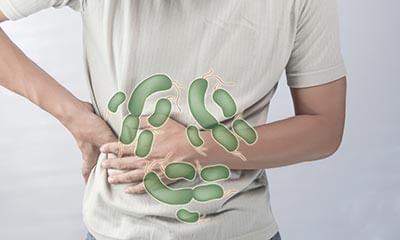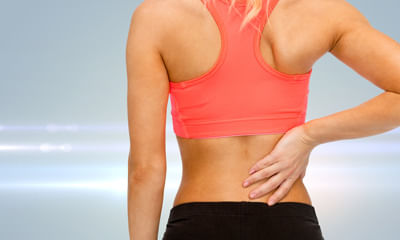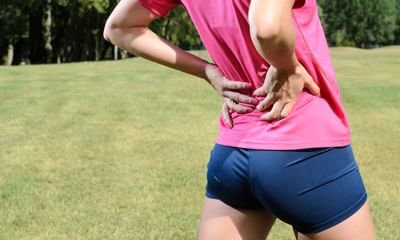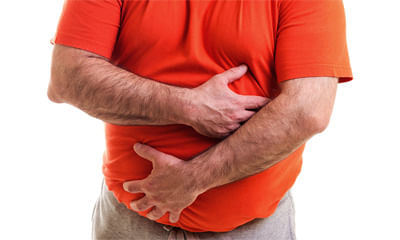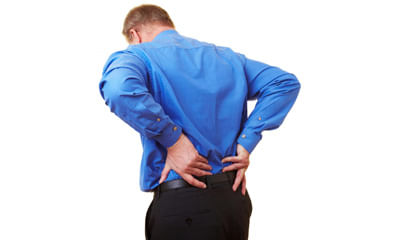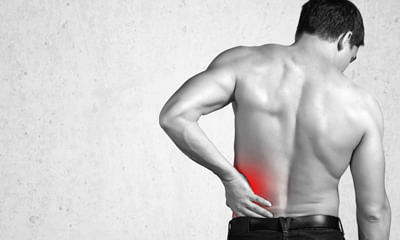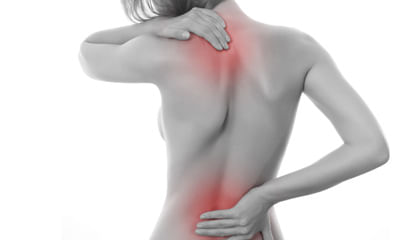My Lower Stomach Is Getting Bigger
I am 63 years old male and I am suffering from sharp disturbing pain in the lower left abdomen, it happen three times in ...
Ask Free Question
Get usg abdomen done. It could be a small stone in ureter or it could be intestinal problem or appendicitis. It could also be just gas or hard stool. It can also be muscular. Usg will rule out structure problems. If no problem found, we can treat it empiricallly by medicine. No big problem. If something found in usg, treat as such. Do contact me for further diagnosis and treatment if you feel necessary.
I am 25 year old female, I have side, back, joints and muscle pains and have checked my kidney function ,is function wel ...
Ask Free Question
What is your age? Since when r you having this? What r other symptoms that you r experiencing? By doing what like walking, exertion, eating or empty stomach- it increases or decreases in intensity. For how much time it remains? Is there stiffness also? How is your appetite? R you constipated or having loose stools? Any problem in urine? I need details of the case.in the meanwhile do test your hb, blood sugar, thyroid function test, vit d, calcium. Follow this 1. Take your breakfast every day. Don't skip it. U should eat whatever your mother or grandparent eat in bfast. I mean to say whatever is your traditional food. If punjabi eat paratha, if belongs to south then take idli/ dosa etc. 2. Don't overeat 3. Don't take tea empty stomach. Eat something like a banana (if you are not diabetic) or any seasonal fruit or soaked almonds and a glass of plain water first thing in the morning (preferably within 10 mins of waking up). No only biscuits or rusk will not do. 4. Have light meals every 2 hours (in addition to your breakfast, lunch n dinner) e.g. Nariyal paani, chaach, a handful of mixed dry fruits, a handful of peanuts, any fresh n seasonal fruit (eat whole fruit not juice), a cup of curd/milk etc 5. Take simple food like rice n dal in dinner. Finish your dinner at least 2 hours before going to sleep. 6. Maintain active life style 7. Avoid fast foods, spicy n fried foods, carbonated beverages 8. Take a lot of green vegetables n fruit. 9. Drink lot of water. 10. Everyday preferably sleep on same time 11. Take 1tsp of ghee in bfast, lunch n dinner. Exercise in the form of yoga, cycling, swimming, gym etc.
I am 26 years I have backache very badly from couple of months. Severe pain I am facing .what should I do? ...
Ask Free Question
Back pain can have causes that aren't due to underlying disease. Examples include overuse such as working out or lifting too much, prolonged sitting and lying down, sleeping in an uncomfortable position or wearing a poorly fitting backpack. Doing exercises to strengthen the lower back can help alleviate and prevent lower back pain. It can also strengthen the core, leg, and arm muscles. Exercise also increases blood flow to the lower back area, which may reduce stiffness and speed up the healing process. Below are exercises that strengthen the lower back and help manage lower back pain: 1. Bridges lie on the ground and bend the knees, placing the feet flat on the floor hip-width apart. Press the feet into the floor, keeping the arms by the sides. Raise the buttocks off the ground until the body forms a straight line from the shoulders to the knees. Squeeze the buttocks with the shoulders remaining on the floor. Lower the buttocks to the ground and rest for a few seconds. Repeat 15 times and then rest for 1 minute. Do 3 sets of 15 repetitions. 2. Knee-to-chest stretchesâ lie on the back on the floor. Bend the knees, keeping both feet flat on the floor. Use both hands to pull one knee in toward the chest. Hold the knee against the chest for 5 seconds, keeping the abdominals tight and pressing the spine into the floor. Return to the starting position. Repeat with the opposite leg. Repeat with each leg 2â3 times twice a day. 3. Lower back rotational stretchesâlie back on the floor with bent knees and feet flat on the ground. Keeping the shoulders firmly on the floor, gently roll both bent knees over to one side. Hold the position for 5â10 seconds. Return to the starting position. Gently roll the bent knees over to the opposite side, hold, and then return to the starting position. Repeat 2-3 times on each side twice a day. 4. Draw-in maneuversâ lie back on the floor with knees bent and feet flat, keeping the arms by the sides. Breathe in deeply. While breathing out, pull the bellybutton toward the spine, tightening the abdominal muscles and keeping the hips still. Hold the position for 5 seconds. Repeat 5 times. 5. Pelvic tiltsâ lie back on the floor with knees bent and feet flat, keeping the arms by the sides. Gently arch the lower back and push the stomach out. Hold for 5 seconds, then relax. Flatten the back and pull the bellybutton in toward the floor. Hold for 5 seconds, then relax. Increase the number of repetitions daily, building up to 30. 6. Lying lateral leg liftsâ lie on one side with the legs together. Keep the lower leg slightly bent. Draw the bellybutton into the spine to engage the core muscles. Raise the top leg about 18 inches, keeping it straight and extended. Hold the position for 2 seconds. Repeat 10 times. Turn onto the other side of the body and repeat, lifting the other leg. Perform 3 sets on each side. 7. Cat stretchesâ get onto the hands and knees with the knees hip-width apart. Arch the back, pulling the bellybutton up toward the spine. Slowly relax the muscles and allow the abdomen to sag toward the floor. Return to the starting position. Repeat 3â5 times twice a day. 8. Supermansâ lie face down on the ground and stretch both arms out in front of the body, keeping the legs stretched out and flat on the ground. Raise both the hands and feet, aiming to create a gap of about 6 inches between them and the floor. Try to pull in the bellybutton, lifting it off the floor to engage the core muscles. Keep the head straight and look at the floor to avoid neck injury. Stretch the hands and feet outward as far as possible. Hold the position for 2 seconds. Return to the starting position. Repeat 10 times. For this homeopathic treatment is very effective consult online with details.
I ate lot of food and my stomach right side part pained for few minutes and after gas is out it is okay now. Does over e ...
Ask Free Question
Yes over eating is a big issue. Take balance diet always. Keep fast once a week to normalise abdominal problem.
I have altered bowel habits with chronic constipation and diarrhea even in night, incomplete ness of motion always feeli ...
Ask Free Question
Stool test complete n microscopic. Enterogermina respule two times a day for improving floora so loose motions control. Add big bowl of salad two times a day before meals. Butter milk. Kadhi khichdi poha upma uttpam. Rice curd rice daal. No or least spicy. No fried food. Pan d one in empty stomach for two weeks. Cyclopam for pain abdomen. U r on wrong place you r not a case for open platform. You need superspeialist. Gastroenterology or md physician.
I have started my workouts from past 6 months everything was good. But from past 7 days while specifically doing push up ...
Ask Free Question
Anaemia always leads to the symptoms of being tired and also having leg pain though there are no issues with the knee joint or back pain. This is quite common with pushups activity please consume good diet - vitamin d and iron diet which will help you to have good nourishment and strength to carry out gym activity. For your age there is no need for any treatment.
Hello, i'm 22 yo boy. Its 3rd day im having fever that also causing pain in knees and lower back, my immunity system is ...
Ask Free Question
Get your thyroid profile, cbc, blood sugar fasting checked from some lab. In the meanwhile follow this 1. Don't take tea empty stomach. Eat something like a banana (if you are not diabetic) or any seasonal fruit or soaked almonds and a glass of water first thing in the morning (within 10 mins of waking up). No only biscuits or rusk will not do. 2. Don't overeat 3. Take your breakfast every day. Don't skip it. U should eat whatever your mother or grandparent eat in bfast. I mean to say whatever is your traditional food. If punjabi eat paratha, if belongs to south then take idli/ dosa etc. 4. Have light meals every 2 hours (in addition to your breakfast, lunch n dinner) e.g. Nariyal paani, chaach, a handful of dry fruits, a handful of peanuts, any fresh n seasonal fruit, a cup of curd/milk etc 5. Finish your dinner at least 2 hours before going to sleep. 6. Maintain active life style7. Avoid fast foods, spicy n fried foods, carbonated beverages 8. Take a lot of green vegetables n fruit. 9. Drink lot of water.10. Everyday preferably sleep on same time exercise in the form of yoga, cycling, swimming, gym etc.For more details, you can consult me.
I have pain in the lower part of backbone just above the hip in the right side .from last seven days it is continuously ...
Ask Free Question
Anterior pelvic tilt 1.Lie on the back with the knees bent and feet flat on the floor, hip-width apart. 2.Squeeze the buttocks and tilt the pelvis upward. 3.The back should feel as though it is flattening to the ground. 4.Return to normal pelvis position. 5.Repeat 10–12 times 6..tb spine -spinal fusion surgery •tens (transcutaneous electrical neuromuscular stimulation) •aquatic therapy •overground training (walking program) •aerobic exercise •trunk strengthening studies examining the use of tens have shown higher frequencies are more effective in decreasing neuropathic pain. Aerobic exercise, pt, and trunk strengthening interventions have pt managment post-spinal decompression surgery •spinal stabilization exercises •maitland •back school •exercise and strengthening when compared with other physical therapy treatments and self-managment, spinal stabilization exercises were found to produce significantly more positive ratings in global outcomes. Pain and disability, however, did not show significant improvement when compared to the other two treatment options.[13] pt managmentpostall attained significant decreases in pain, psychological distress and disability.[14] postural correction exercise 1. Child’s pose this resting pose stretches and lengthens your spine, glutes, and hamstrings. The child’s pose helps to release tension in your lower back and neck. To do this: 1.Sit on your shinbones with your knees together, your big toes touching, and your heels splayed out to the side. 2.Fold forward at your hips and walk your hands out in front of you. 3.Sink your hips back down toward your feet. If your thighs won’t go all the way down, place a pillow or folded blanket under them for support. 4.Gently place your forehead on the floor or turn your head to one side. 5.Keep your arms extended or rest them along your body. 6.Breathe deeply into the back of your rib cage and waist. 7.Relax in this pose for up to 5 minutes while continuing to breathe deeply. 2. Forward fold this standing stretch releases tension in your spine, hamstrings, and glutes. It also stretches your hips and legs. While doing this stretch, you should feel the entire back side of your body opening up and lengthening. To do this: 1.Stand with your big toes touching and your heels slightly apart. 2.Bring your hands to your hips and fold forward at your hips. 3.Release your hands toward the floor or place them on a block. Don’t worry if your hands don’t touch the ground — just go as far as you can. 4.Bend your knees slightly, soften your hips joints, and allow your spine to lengthen. 5.Tuck your chin into your chest and allow your head to fall heavy to the floor. 6.Remain in this pose for up to 1 minute. 3. Cat cow practicing cat cow stretches and massages your spine. It also helps to relieve tension in your torso, shoulders, and neck while promoting blood circulation. To do this: 1.Come onto your hands and knees with your weight balanced evenly between all four points. 2.Inhale to look up, dropping your abdomen down toward the ground as you extend your spine. 3.Exhale and arch your spine toward the ceiling and tuck your chin into your chest. 4.Continue this movement for at least 1 minute. 4. Standing cat cow doing the cat cow stretch while standing helps to loosen up tightness in your back, hips, and glutes. To do this: 1.Stand with your feet about hip-width apart with a slight bend in your knees. 2.Extend your hands in front of you or place them on your thighs. 3.Lengthen your neck, bring your chin toward your chest, and round your spine. 4.Then look up, lift your chest, and move your spine in the opposite direction. 5.Hold each position for 5 breaths at a time. 6.Continue this movement for a few minutes. 5. Chest opener this exercise allows you to open and stretch your chest. This is especially useful if you spend most of your day sitting, which tends to make your chest move inward. Strengthening your chest also helps you stand up straighter. To do this: 1.Stand with your feet about hip-width apart. 2.Bring your arms behind you and interlace your fingers with your palms pressing together. Grasp a towel if your hands don’t reach each other. 3.Keep your head, neck, and spine in one line as you gaze straight ahead. 4.Inhale as you lift your chest toward the ceiling and bring your hands toward the floor. 5.Breathe deeply as you hold this pose for 5 breaths. 6.Release and relax for a few breaths. 7.Repeat at least 10 times. Ready to see how this all fits into an exercise plan? Check out our guide for better posture in 30 days. 6. High plank the high plank pose helps to relieve pain and stiffness throughout your body while strengthening your shoulders, glutes, and hamstrings. It also helps you develop balance and strength in your core and back, both important for good posture. To do this: 1.Come onto all fours and straighten your legs, lift your heels, and raise your hips. 2.Straighten your back and engage your abdominal, arm, and leg muscles. 3.Lengthen the back of your neck, soften your throat, and look down at the floor. 4.Make sure to keep your chest open and your shoulders back. 5.Hold this position for up to 1 minute at a time. 7. Side plank you can use a side plank to maintain the neutral alignment of your spine and legs. This energizing pose works the muscles in your sides and glutes. Strengthening and aligning these muscles helps to support your back and improve posture. To do this: 1.From a high plank position, bring your left hand slightly in to center. 2.Shift your weight onto your left hand, stack your ankles, and lift your hips. 3.Place your right hand on your hip or extend it up toward the ceiling. 4.You can drop your left knee down to the floor for extra support. 5.Engage your abdominals, side body, and glutes as you maintain this pose. 6.Align your body in a straight line from the crown of your head to your heels. 7.Look straight ahead of you or up toward your hand. 8.Hold this pose for up to 30 seconds. 9.Repeat on the opposite side. 8. Downward-facing dog this is a forward bend that can be used as a resting pose to balance out your body. The downward-facing dog pose helps to relieve back pain, while also strengthening and aligning your back muscles. Practicing it regularly helps to improve posture. To do this: 1.Lying with your stomach on the floor, press into your hands as you tuck your toes under your feet and lift your heels. 2.Lift your knees and hips to bring your sitting bones up toward the ceiling. 3.Bend your knees slightly and lengthen your spine. 4.Keep your ears in line with your upper arms or tuck your chin all the way into your chest. 5.Press firmly into your hands and keep your heels slightly lifted. 6.Remain in this pose for up to 1 minute. 9. Pigeon pose this is a hip opener that also loosens up your spine, hamstrings, and glutes. The pigeon pose can also help to stretch your sciatic nerve and quadriceps. Opening and stretching these places in your body makes it easier to correct imbalances in your posture. To do this: 1.Come down on all fours with your knees below your hips and your hands a little bit in front of your shoulders. 2.Bend your right knee and place it behind your right wrist with your right foot angled out to the left. 3.Rest the outside of your right shin on the floor. 4.Slide your left leg back, straighten your knee, and rest your thigh on the floor. 5.Make sure your left leg extends straight back (and not to the side). 6.Slowly lower your torso down to rest on your inner right thigh with your arms extended in front of you. 7.Hold this position for up to 1 minute. 8.Slowly release the position by walking your hands back toward your hips and lifting your torso. 9.Repeat on the left side. 10. Thoracic spine rotation this exercise relieves tightness and pain in your back while increasing stability and mobility. To do this: •come onto all fours and sink your hips back down to your heels and rest on your shins. •place your left hand behind your head with your elbow extended to the side. •keep your right hand under your shoulder or bring it to center and rest on your forearm. •exhale as you rotate your left elbow up toward the ceiling and stretch the front of your torso. •take one long inhale and exhale in this position. •release back down to the original position. •repeat this movement 5 to 10 times. •repeat on the opposite side. 11. Glute squeezes this exercise helps to strengthen and activate your glutes while relieving lower back pain. It also improves the functioning and alignment of your hips and pelvis, leading to better posture. To do this: 1.Lie on your back with your knees bent and your feet about hip-distance apart. 2.Keep your feet about a foot away from your hips. 3.Rest your arms alongside your body with your palms facing down. 4.Exhale as you bring your feet closer to your hips. 5.Hold this position for 10 seconds and then move them further away from your hips. 6.Continue this movement for 1 minute. 7.Do this exercise a few times per day. 12. Isometric rows this exercise helps to relieve pain and stiffness from sitting in one place for too long. Isometric pulls work your shoulder, arm, and back muscles, giving you the strength to maintain good posture. To do this: 1.Sit in a chair with a soft back. 2.Bend your arms so your fingers are facing forward and your palms are facing each other. 3.Exhale as you draw your elbows back into the chair behind you and squeeze your shoulder blades together. 4.Breathe deeply as you hold this position for 10 seconds. 5.On an inhale, slowly release to the starting position. 6.Repeat this movement for 1 minute. 7.Do this exercise several times throughout.
Hello sir/ma'am, when the pandemic began, I started doing home workout and weight lifting. After few months I felt back ...
Ask Free Question
Hi first of all if you have back pain the most important thing would be subside the immediately with the help of ice packs or by doing hot water fermentation. This is mandatory and this is the first and foremost thing you need to do. However exercises and physiotherapy exercises there is no big difference. The only difference is in general exercises you will concentrate more on fitness and you may not prevent moving rigorously your back. But in physiotherapy exercises for the back pain we initially concentrate only on the abdomen strengthening exercises and slowly we will teach you the spinal strengthening exercises which is mandatory. If you want we can help you to learn this from our end by doing a video call. Let us know. And also the general literature I am sharing here for you to have better understanding. However you can go for regular exercises but please avoid jogging and running as your back bone ie. The lower end of the lumbar vertebrae and the sacral vertebrae is inflamed and you need to give rest to that area by applying ice packs, doing hot water fermentation and also by wearing lumbo sacral corset. If you want that we can provide you the same as it definitely helps you to strengthen the abdominal muscles and also the abdominal muscle tone. Back pain / sciatica: back pain can affect people of any age, for different reasonsas people get older, the chance of developing lower back pain increases, due to factors such as previous occupation and degenerative disk disease. Lower back pain may be linked to the bony lumbar spine, discs between the vertebrae, ligaments around the spine and discs, spinal cord and nerves, lower back muscles, abdominal and pelvic internal organs, and the skin around the lumbar area. •acute pain starts suddenly and lasts for up to 6 weeks. •chronic or long-term pain develops over a longer period, lasts for over 3 months, and causes ongoing problems. Home advise: •resting from strenuous activity can help, but moving around will ease stiffness, reduce pain, and prevent muscles from weakening. •applying heat, ice, ultrasound, and electrical stimulation — as well as some muscle-release techniques to the back muscles and soft tissues — may help alleviate pain. •as the pain improves, the physical therapist may introduce some flexibility and strength exercises for the back and abdominal muscles. Techniques for improving posture may also help. •the patient will be encouraged to practice the techniques regularly, even after the pain has gone, to prevent back pain recurrence. Regular exercise helps build strength and control body weight. Guided, low-impact aerobic activities can boost heart health without straining or jerking the back. Before starting any exercise program, talk to a health care professional. There are two main types of exercise that people can do to reduce the risk of back pain: •core-strengthening exercises work the abdominal and back muscles, helping to strengthen muscles that protect the back. •flexibility training aims at improving core flexibility, including the spine, hips, and upper legs. We suggest you to wear lumbosacral corset (belt) which is available at our clinic. If you want you can buy from us, if you are far away from chennai we can send you by courier. The reason why we are conveying you to buy from us is we can demonstrate over the videocall (using whatsapp) and also we can monitor you throughout when to wear it and how long to wear it. And also if you find any difficulty wearing the brace you can also revert back to us for few more suggestions and we can propose you good solution how to go about it. Uses of lumbosacral corset (belt) a lumbosacral corset adds pressure to the intra-abdominal area. This adds stability to the spine. It is prescribed to people suffering from moderate to severe pain. Other benefits of using a lumbar spine belt are: 1.helps in a certain degree of immobilization of facet joints. 2.reduces pain to allow continuation of normal activities. 3.speeds up the healing process. 4.the pressure exerted by a lumbar spine belt helps in stretching the erector spine muscles. 5.this belt can also be used to support the lower back while exercising. Ohelps prevent rolling oprovides stability to lumbar and sacral regions of the back ocan be used when performing actions like lifting and handling heavy items ocan also be used when playing sports orestricts back movement to aid treatment of back problems do’s and don’ts sitting do: • sit as little as possible and then only for short periods. • place a supportive towel roll at the belt line of the back especially when sitting in a car. • when getting up from sitting, keep the normal curves in your back. Move to the front of the seat and stand up by straightening your legs. Avoid bending forward at the waist. • try to keep the normal curves in your back at all times. Don’t: • do not sit on a low soft couch with a deep seat. It will force you to sit with your hips lower than your knees and will round your back. You will loose the normal curve in your back. • do not place your legs straight out in front of you while sitting (e.g. Sitting in the bath tub). Standing do: • if you must stand for a long period of time, keep one leg up on a foot stool. • adapt work heights. Don’t: • avoid half bent positions. Lifting avoid lifting if you can. Do: • use the correct lifting technique. Keep your back straight when lifting. Never stoop or bend forward. Stand close to the load, have a firm footing and wide stance. Kneel on one knee, keeping the back straight. Have a secure grip on the load and lift by straightening your knees. Do a steady lift. Shift your feet to turn and do not twist your back. Don’t: • do not jerk when you lift. • do not bend over the object you are lifting. Lying do: • sleep on a good firm surface. • if your bed sags, use slats or plywood supports between the mattress and base to firm it. You also can place the mattress on the floor, a simple but temporary solution. • you may be more comfortable at night when you use a pillow for support. Don’t: • do not sleep on your stomach unless advised to do so by your doctor or physical therapist. Bending forward do: • keep the natural curves of your back when doing these and other activities: making a bed, vacuuming, sweeping or mopping the floor, weeding the garden or raking leaves. Coughing and sneezing do: • bend backwards to increase the curve of your back while you cough or sneeze. Driving a car do: • drive the car as little as possible. It is better to be a passenger than to drive yourself. • move the seat forward to the steering wheel. Your seat must be close enough to the wheel to keep the natural curves of your back. If your hips are lower than your knees in this position, raise yourself by sitting on a pillow. Exercises for low back pain safety guidelines • an increase in your low back pain can be expected with these exercises. This is acceptable as long as your leg symptoms are not increasing. • if while doing these exercises, your pain worsens or you have new pain or symptoms, stop the exercises and discuss your symptoms with your doctor or physical therapist. • stop exercising and let your doctor or physical therapist know right away if you have any change in your bowel or bladder control or any increase in weakness in your leg or foot. Exercises ‰ •press-ups: keep your back and buttocks relaxed and use your arms to press up. Concentrate on keeping your hips down and push up your upper body as high as possible. •double knee to chest: grasp both your knees with your hands and pull toward your shoulders. Hold the stretch for 1 second. Let your knees return, but keep them bent at arms length. ‰ •lumbar spine stretches: lie on your back. Bring your knees towards your chest. Rotate your knees towards the pain. •side-lying position: lie on your side and face forward. Have both arms straight in front and bend your knees. Turn your head as you move your top arm across your body as far as you can. Keep your arm in place and turn your head back to the starting position. Look back again and turn your head farther if you can. Bring your head and arm back to the starting position. Relax and repeat 10 times on each side. •hamstring stretch: lie on your back with your legs out straight. Raise your leg up and put your hands around the upper leg for support. Slowly straighten the raised knee until you feel a stretch in the back of the upper leg. Hold, then relax and repeat 10 times on each leg. •standing arch: stand with your feet apart and hands on the small of your back with fingers pointing backwards. Bend backwards at the waist, supporting the trunk with your hands. Keep your knees straight. Hold for 5 seconds. Repeat 3 to 5 times. Side glides: stand at a right angle to the wall about 2 feet o eliminate your pain improve your muscular endurance and strength attain better posture, balance, body awareness and co-ordination improve your balance and flexibility learn to lift properly. posture when standing: make sure you have a neutral pelvic position. Stand upright, head facing forward, back straight, and balance your weight evenly on both feet. Keep your legs straight and your head in line with your spine. Posture when sitting: a good seat for working should have good back support, arm rests and a swivel base. When sitting, try to keep your knees and hips level and keep your feet flat on the floor, or use a footstool. You should ideally be able to sit upright with support in the small of your back. If you are using a keyboard, make sure your elbows are at right-angles and that your forearms are horizontal. Shoes: flat shoes place less of a strain on the back. Driving: it is important to have proper support for your back. Make sure the wing mirrors are properly positioned so you do not need to twist. The pedals should be squarely in front of your feet. If you are on a long journey, have plenty of breaks. Get out of the car and walk around. Bed: you should have a mattress that keeps your spine straight, while at the same time supporting the weight of your shoulders and buttocks. Use a pillow, but not one that forces your neck into a steep angle. Posture supportspoor sitting posture is a common cause of sciatica. To assist the support of your lower back many simple and effective products have been developed over time. These include: lumbar d-roll bassett frame kinesiology lumbar tape please ask your physiotherapist for their advice in what will help you most. Exercise sciatic nerve pain 1. Reclining pigeon posepigeon pose is a common yoga pose. It works to open the hips. There are multiple versions of this stretch. The first is a starting version known as the reclining pigeon pose. If you are just starting your treatment, you should try the reclining pose first. 1.While on your back, bring your right leg up to a right angle. Clasp both hands behind the thigh, locking your fingers. 2.Lift your left leg and place your right on top of the left knee. 3.Hold the position for a moment. This helps stretch the tiny piriformis muscle, which sometimes becomes inflamed and presses against the sciatic nerve, causing pain. 4.Do the same exercise with the other leg. Once you can do the reclining version without pain, work with your physical therapist on the sitting and forward versions of pigeon pose. 2. Sitting pigeon pose 1.Sit on the floor with your legs stretched out straight in front of you. 2.Bend your right leg, putting your right ankle on top of the left knee. 3.Lean forward and allow your upper body to reach toward your thigh. 4.Hold for 15 to 30 seconds. This stretches the glutes and lower back. 5.Repeat on the other side. 3. Forward pigeon pose 1.Kneel on the floor on all fours. 2.Pick up your right leg and move it forward on the ground in front of your body. Your lower leg should be on the ground, horizontal to the body. Your right foot should be in front of your right knee while your right knee stays to the right. 3.Stretch the left leg out all the way behind you on the floor, with the top of the foot on the ground and toes pointing back. 4.Shift your body weight gradually from your arms to your legs so that your legs are supporting your weight. Sit up straight with your hands on either side of your legs. 5.Take a deep breath. While exhaling, lean your upper body forward over your front leg. Support your weight with your arms as much as possible. 6.Repeat on the other side. 7.4. Knee to opposite shoulder this simple stretch helps relieve sciatica pain by loosening your gluteal and piriformis muscles, which can become inflamed and press against the sciatic nerve. 1.Lie on your back with your legs extended and your feet flexed upward. 2.Bend your right leg and clasp your hands around the knee. 3.Gently pull your right leg ac 4.5.6.7.Ross your body toward your left shoulder. Hold it there for 30 seconds. Remember to pull your knee only as far as it will comfortably go. You should feel a relieving stretch in your muscle, not pain. 8.Push your knee so your leg returns to its starting position. 9.Repeat for a total of 3 reps, and then switch legs. 5.sitting spinal stretch sciatica pain is triggered when vertebrae in the spine compress. This stretch helps create space in the spine to relieve pressure on the sciatic nerve. 1.Sit on the ground with your legs extended straight out with your feet flexed upward. 2.Bend your right knee and place your foot flat on the floor on the outside of your opposite knee. 3.Place your left elbow on the outside of your right knee to help you gently turn your body toward the right. 4.Hold for 30 seconds and repeat three times, then switch sides. 6. Standing hamstring stretch this stretch can help ease pain and tightness in the hamstring caused by sciatica. 1.Place your right foot on an elevated surface at or below your hip level. This could be a chair, ottoman, or step on a staircase. Flex your foot so your toes and leg are straight. If your knee tends to hyperextend, keep a slight bend in it. 2.Bend your body forward slightly toward your foot. The further you go, the deeper the stretch. Do not push so far that you feel pain. 3.Release the hip of your raised leg downward as opposed to lifting it up. If you need help easing your hip down, loop a yoga strap or long exercise band over your right thigh and under your left foot. 4.Hold for at least 30 seconds, and then repeat on the other sideif you have low back pain and sciatica you can undergo intermittent pelvic traction where in your half of your body weight will be added in the electronic traction so that that would help you to reduce the pain, along with interferential therapy stimulations which would help you to get relieved from the radiating pain. Apply ice for the pain to get subsided immediately. If you cannot go immediately for the physiotherapy treatment. Ice can be kept in the low back where you have back pain. It is suggestible to wear lumbo sacral belt which would help you to build the abdominal muscle tone which itself would make you feel better. You can also wear mcr chappals which would help you to have less weight falling in the painful back. U have to take vitamin d rich foods. Likemilk,cheese, yogurt,brocoli, spinach.u need calcium consumption for increase the bone density. Lackof bone and bones crush inside the body this might be due to low calcium or vitamin d which has more impact on the bone density and also it makes one to feel that there is lack of bone strength or in a way the bones are brittle and almost breaking and they feel it is crushed in a way there are many bones breaking at the same time. You have to take vitamin d rich foods. Likemilk,cheese, yogurt, brocoli, spinach.u need calcium consumption for increase the bone density. vitamin d intake via supplements or exposure to low levels of sunlight. Vitamin d is used to absorb calcium in the bone and regulate calcium in the blood.
20 years old female. Feel pain in my 1st metatarsophalangeal joint without any swelling mostly both the legs, currently ...
Ask Free Question
Get your thyroid profile, cbc, blood sugar fasting checked from some lab. In the meanwhile follow this 1. Don't take tea empty stomach. Eat something like a banana (if you are not diabetic) or any seasonal fruit or soaked almonds and a glass of water first thing in the morning (within 10 mins of waking up). No only biscuits or rusk will not do. 2. Don't overeat 3. Take your breakfast every day. Don't skip it. U should eat whatever your mother or grandparent eat in bfast. I mean to say whatever is your traditional food. If punjabi eat paratha, if belongs to south then take idli/ dosa etc. 4. Have light meals every 2 hours (in addition to your breakfast, lunch n dinner) e.g. Nariyal paani, chaach, a handful of dry fruits, a handful of peanuts, any fresh n seasonal fruit, a cup of curd/milk etc 5. Finish your dinner at least 2 hours before going to sleep. 6. Maintain active life style7. Avoid fast foods, spicy n fried foods, carbonated beverages 8. Take a lot of green vegetables n fruit. 9. Drink lot of water.10. Everyday preferably sleep on same time exercise in the form of yoga, cycling, swimming, gym etc.For more details, you can consult me.

